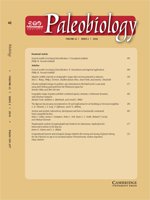Evolutionary paleoecologists have proposed many explanations for Phanerozoic trends in ecospace utilization, including escalation, seafood through time, filling of an empty ecospace, and tiering, among others. These hypotheses can be generalized into four models of functional diversification within a life-habit ecospace framework (functional-trait space). The models also incorporate concepts in community assembly, functional diversity, evolutionary diversification, and morphological disparity. The redundancy model produces an ecospace composed of clusters of functionally similar taxa. The partitioning model produces an ecospace that is progressively subdivided by taxa along life-habit gradients. The expansion model produces an ecospace that becomes progressively enlarged by the accumulation of taxa with novel life habits. These models can be caused by a wide range of ecological and evolutionary processes, but they are all caused by particular “driven” mechanisms. A fourth, neutral model also exists, in which ecospace is filled at random by life habits: this model can serve as a passive null model. Each model produces distinct dynamics for functional diversity/disparity statistics when simulated by stochastic simulations of ecospace diversification. In this first of two companion articles, I summarize the theoretical bases of these models, describe their expected statistical dynamics, and discuss their relevance to important paleoecological trends and theories. Although most synoptic interpretations of Phanerozoic ecological history invoke one or more of the driven models, I argue that this conclusion is premature until tests are conducted that provide better statistical support for them over simpler passive models.
How to translate text using browser tools
1 May 2016
General models of ecological diversification. I. Conceptual synthesis
Philip M. Novack-Gottshall
ACCESS THE FULL ARTICLE

Paleobiology
Vol. 42 • No. 2
Spring 2016
Vol. 42 • No. 2
Spring 2016




